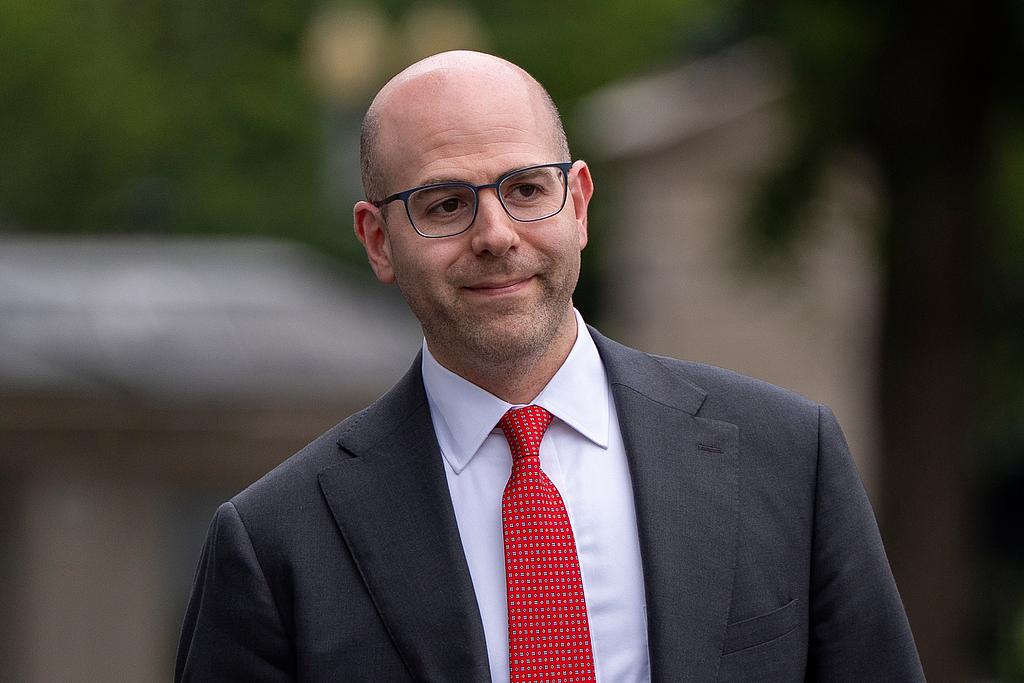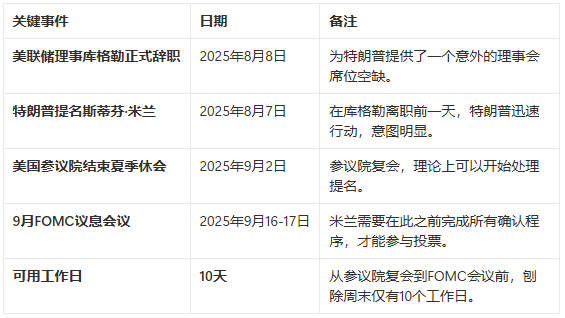Author: Luke, Mars Finance

On the chessboard of the macroeconomy, the global market's attention was once focused like a spotlight on a single point: whether the US economic data in September could pave the way for the Federal Reserve's interest rate cuts. Traders analyzed every employment report and inflation index as if deciphering an oracle, and the core contradiction on Wall Street seemed to simplify into a mathematical problem about "economic recession" versus "inflation resilience."
However, in early August, a sudden political variable, like a "stranger" pushing through the door, instantly changed the nature of the game. The unexpected resignation of Federal Reserve Governor Adriana Kugler, along with President Trump's immediate nomination of his economic advisor Stephen Miran to take over on August 7, escalated the market's core contradiction dramatically.
The question was no longer just "Does the economic data support rate cuts?" but rather "Can the president's political will override the Federal Reserve's established procedures?" This "stranger" named Stephen Miran not only brought short-term volatility to the market but, more importantly, carried with him a set of radical ideas that could fundamentally rewrite the rules of the game between the Federal Reserve and the dollar system.
An Impossible "Hotline Appointment"
The initial market turmoil stemmed from an extremely subtle time lag. Trump hoped Miran could quickly enter the Federal Reserve and cast a crucial vote for a rate cut at the FOMC meeting on September 17. However, the institutional gears of American politics turn much slower than politicians expect.
Let's first look at this nearly error-free timeline:

In just 10 working days, a complete confirmation process for a Federal Reserve governor must be completed—including background checks by the Senate Banking Committee, hearings, committee votes, and finally submission for full Senate debate and voting—this is nearly an impossible task in modern American politics. According to data from the Brookings Institution, the average confirmation process for government nominations during Trump's second term has reached a record 94 days.
Moreover, Democratic leaders on the Senate Banking Committee, such as Elizabeth Warren, have publicly labeled Miran as "Trump's loyalist" and expressed serious concerns about his policy proposals, indicating they would use all procedural tools to delay this process.
Therefore, the first and most superficial conclusion about this event is already clear: Stephen Miran is almost certainly not going to vote at the September meeting. The direct impact of this event on the rate cut in September is minimal.
So, if Trump was not aiming to influence the September rate decision, what was his true deeper calculation? The answer lies within Stephen Miran himself and the ideas he represents.
Miran's "Arsenal": He Wants to Transform More Than Just Interest Rates
Labeling Stephen Miran simply as "Trump's man" or "the rate cut faction" would severely underestimate his energy and the subversive nature of his ideas. He is not merely a policy executor but an economic thinker with a systematic worldview, a "designer" attempting to reconstruct the system from the ground up.
His resume is impressive, holding a PhD in economics from Harvard University, studying under the renowned economist Martin Feldstein from the Reagan era. Before entering the White House, he not only had key experiences in the Treasury Department but also served as the global macro strategy head at the well-known hedge fund Hudson Bay Capital. This indicates he understands both theory and the market.
His true danger lies in the two core ideas he has publicly articulated:
First, he advocates fundamentally "transforming" the Federal Reserve. In co-authored articles, Miran sharply criticizes the Federal Reserve for its "groupthink," which has led to serious policy mistakes in the past. His proposed reform plan is radical: placing the independence of the Federal Reserve under the "will" of the president, giving the president greater power to dismiss governors, and even bringing its budget under congressional appropriations control. This is no longer a policy route dispute but an attempt to dismantle the "century-old establishment" of the Federal Reserve as an independent central bank.
Second, he possesses a complete theory of "weaponizing the dollar." In his widely circulated paper "A User's Guide to Restructuring the Global Trade System," Miran systematically explains how to use tariffs and exchange rates as weapons to reshape the global trade landscape. He believes that the overvaluation of the dollar is the root cause of the decline of American manufacturing and envisions the "Mar-a-Lago Accord 2.0," advocating for actively lowering the dollar through multilateral or even unilateral means. His toolbox includes not only using tariffs as core negotiation chips but also options like imposing "usage fees" on foreign-held US debt, a "nuclear weapon" level option.
When these ideas combine with the potential identity of a Federal Reserve governor, a disturbing picture emerges: what Trump wants may be far more than just a few rate cuts. He desires a Federal Reserve that can implement his political will, deeply intertwine monetary policy with trade wars, and even risk undermining the dollar's credibility to achieve his economic goals.
A Three-Birds-One-Stone Scheme and Bitcoin's "Institutional Hedge" Moment
Understanding Miran's core ideas and the "impossible timeline," Trump's move becomes clear as a "three-birds-one-stone" scheme.
First, this is short-term pressure on current Chairman Powell. Even if Miran cannot take office, this nomination itself is a clear political signal, a public "knock" to the entire FOMC, warning them that they must align their monetary policy with the White House.
Second, this lays the groundwork for Miran's bid for the next Federal Reserve chair. Analysts at Barclays have pointed out that Miran could become a "dark horse" for the chair position. Through this nomination, Trump has "crowned" Miran as his most trusted financial advisor in front of the world, allowing him to enter the public eye early and accumulate capital for the competition after Powell's term ends in 2026.
Finally, this sets a long-term agenda to "normalize" radical ideas. Throwing Miran's views into the market is itself a form of testing and pressure. It forces the market to begin discussing and digesting these ideas that were once considered "heretical," laying the groundwork for potentially more radical policies in the future.
And what does all this mean for the crypto world, especially Bitcoin, which is far removed from the traditional financial system?
For a long time, one of Bitcoin's core narratives has been as a "digital gold" hedge against inflation. However, when the world's only superpower, the issuer of the global reserve currency, begins to openly discuss "weaponizing" the central bank and "weaponizing" government debt, Bitcoin's value narrative is quietly elevating.
It is no longer just a tool to hedge against "economic risks" (like inflation) but has become the ultimate tool to hedge against "institutional risks" and "political uncertainties."
The core of this event is the conflict between "human will" and "institutional rules." Miran's theory essentially hopes to place the "president's will" above the century-old rules of the Federal Reserve. This stands in stark contrast to the core principle of the Bitcoin world—"Code is Law." The total issuance, output speed, and transaction rules of Bitcoin are all written in publicly available, transparent code, unaffected by the will of any single strongman. This cold, predictable, mathematically-based certainty is radiating unprecedented appeal in a world where the risks of personal rule are increasingly rising.
When the safest "risk-free asset"—US Treasury bonds—can be viewed by its issuer as a tool to impose fees on other countries, global smart money will be forced to rethink the definition of "risk." This may prompt some of them to seriously turn their attention to that truly independent asset, free from any sovereign state and unbound by any political agenda—Bitcoin.
Therefore, the arrival of this "stranger," Stephen Miran, regardless of whether he ultimately sits at the Federal Reserve's decision-making table, has already provided the most authentic and profound macro commentary in recent years for Bitcoin as an "institutional hedge" tool. This may be the most thought-provoking signal behind this political game in Washington.
免责声明:本文章仅代表作者个人观点,不代表本平台的立场和观点。本文章仅供信息分享,不构成对任何人的任何投资建议。用户与作者之间的任何争议,与本平台无关。如网页中刊载的文章或图片涉及侵权,请提供相关的权利证明和身份证明发送邮件到support@aicoin.com,本平台相关工作人员将会进行核查。




